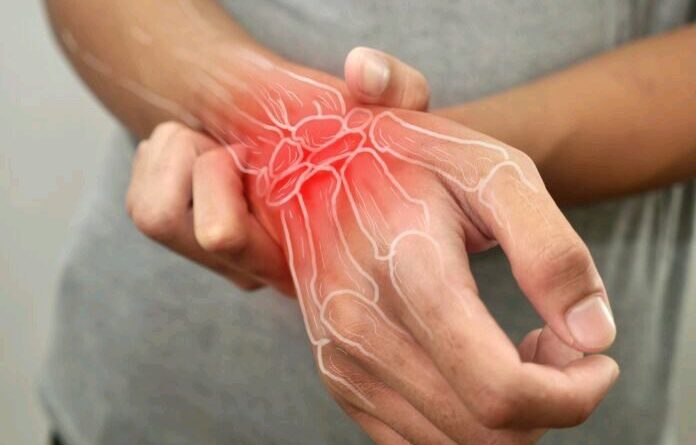What causes Arthritis and how to prevent it
You may notice more aches and pains in your joints as you age. Maybe it’s harder than it used to be to recover from a hard workout. Maybe you’ve noticed some cracking or clicking in your joints or tenderness in your hands and wrists. As we grow older, the wear and tear on our joints can start to take its toll on the body. While it’s common, it can be a painful sign of aging.
What Is Arthritis?
(Credit: Gorodenkoff/Shutterstock)
While there are many forms of arthritis, generally speaking, it’s a disease that can damage the joints. It causes stiffness, cracking, tenderness, and pain. Some arthritis can become so severe that the joints are inflamed, swollen, and painful to the touch. In some cases, arthritis can even make the joints appear deformed.
While some forms of the condition can happen at younger ages, for example, rheumatoid and juvenile arthritis, it’s most common after the age of 50. It can also occur at younger ages for those with repetitive-use injuries like athletes.
What Causes Arthritis?
Lifestyle factors, injuries, genetic predisposition, infections, and immune system dysfunctions are all potential contributors to the development of various types of arthritis. Each type has its unique causes and risk factors. According to the Centers for Disease Control and Prevention, nearly 47 percent of people over 65 have arthritis, while it impacts 26 percent of people between the ages of 45 and 65.
What Are the Risk Factors for Arthritis?
While arthritis can be a part of normal aging, it can also be caused by a host of risk factors. For example, women are more likely to have arthritis, as are athletes and those who stress their joints because of the nature of their jobs. Smoking, genetics, and excess weight can also cause arthritic joint damage.
Read More: What Is Inflammation, and Why Is It Sometimes ‘Bad’ for Your Health?
What Are Common Types of Arthritis?
(Credit: Oporty786/Shutterstock)
While there are numerous types, certain forms are more prevalent. These types of arthritis each have distinct causes and impact patients differently, influencing both treatment approaches and quality of life. But the two most common are osteoarthritis and rheumatoid arthritis.
What Is Osteoarthritis?
Osteoarthritis is common as we age. It’s caused by injuries or even normal wear and tear, which leads to a breakdown in the cartilage that serves as support between the joints. Viral infections such as COVID-19 can aggravate symptoms of osteoarthritis.
What Is Rheumatoid Arthritis?
Rheumatoid arthritis, on the other hand, is caused by the immune system attacking itself and breaking down the joint lining. It can be debilitating and, in many cases, can decrease mobility, even in the young.
What Is Gout?
Gout is a unique type of arthritis characterized by the accumulation of uric acid crystals in the joints. This build-up leads to severe joint pain and inflammation. Gout is often associated with dietary choices and can be intensely painful, affecting the quality of life of those who suffer from it.
What Is Psoriatic Arthritis?
Psoriatic arthritis is directly linked to the skin condition, psoriasis. In individuals with psoriatic arthritis, the skin disease triggers an inflammatory response in the joints. This type of arthritis can lead to joint damage and discomfort, mirroring symptoms found in other forms of arthritis, yet it has its unique root in a dermatological condition.
Read More: Senolytics: A New Weapon in the War on Aging
Can Arthritis Be Cured?
While there is no cure for arthritis, you can take steps to reduce its impact on the body. Over-the-counter pain relievers like aspirin, ibuprofen, and naproxen sodium can relieve arthritis pain and the inflammation that can go along with it.
In some cases, cortisol shots can also be given when OTC medications are no longer effective. Joint replacement or spinal fusion surgeries can also be done when patients have exhausted all non-surgical methods.
Read More: There’s More Than One Type of Pain. Scientists Are Learning to Treat Each of Them
How To Prevent Arthritis
(Credit: PAstudio/Shutterstock)
Athletes are often common patients because they become so addicted to their favorite workouts that they refuse to see the signs of arthritis. If you’re a runner or obsessed with another high-impact sport, it might be time to try a lower-impact sport like walking or swimming.
Read More: 7 Health Home Remedies That Are Actually Effective
Try to stay moving because stagnation can make the condition worse. Physical therapy and other forms of slower, less intense movement might be just what the doctor ordered. Additionally, if you’re obese, losing weight is crucial because putting too much weight on your joints can damage cartilage.
Aging can come with its share of aches and pains, but that doesn’t mean you have to give up the things you love. Rather, consider adjusting them a little. Because if you ignore joint pain for too long, its impact may become irreversible.
Frequently Asked Questions About Arthritis
Is Arthritis Hereditary?
Yes, arthritis can be influenced by genetic factors. While they may increase your risk, it’s not the sole cause. Environmental factors and lifestyle choices also significantly impact the likelihood of developing arthritis.
Is Rheumatoid Arthritis Genetic?
Rheumatoid arthritis has a genetic component. Genes related to the immune system, such as the human leukocyte antigen (HLA) genes, are linked to a heightened risk of developing rheumatoid arthritis. However, possessing these genes doesn’t ensure one will develop the condition; environmental influences and other factors also play a role.
Does Cracking Knuckles Cause Arthritis?
There is no evidence to suggest that cracking your knuckles causes arthritis. This habit results in the popping sound due to the bursting of gas bubbles in the synovial fluid within the joints. Research has not demonstrated a connection between knuckle cracking and an increased risk of developing arthritis.
How to Get Rid of Arthritis in Fingers?
While arthritis in the fingers cannot be completely cured, its symptoms can be managed. Treatment options include medications like anti-inflammatory drugs, pain relievers, and in some cases, disease-modifying antirheumatic drugs (DMARDs). Physical therapy, exercises to strengthen the fingers and improve flexibility, and in severe cases, surgery, can also help alleviate symptoms. Lifestyle changes like managing weight, adopting a healthy diet, and using heat and cold therapies can provide relief.
How to Test for Rheumatoid Arthritis?
Testing for rheumatoid arthritis typically involves a combination of methods. Blood tests can detect antibodies like rheumatoid factor (RF) and anti-cyclic citrullinated peptide (anti-CCP) antibodies, which are often present in rheumatoid arthritis. Inflammatory markers such as ESR (erythrocyte sedimentation rate) and CRP (C-reactive protein) are also measured. Additionally, physical examinations and imaging tests like X-rays, MRI, and ultrasound can assess joint damage and inflammation.
Read More: Debunking These 3 Popular Kid Sayings About Health
Source : Discovermagazine




